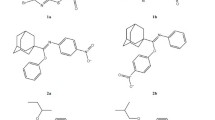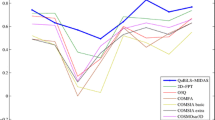Summary
A 3D QSAR methodology based on the combined use of conformational analysis and chemometrics was applied to perform a comparative analysis of the 3D conformational features of 13 nonpeptide angiotensin II receptor antagonists showing different levels of binding affinity. Conformational analysis by using a molecular mechanics MM2 method was carried out for each of these structures to obtain conformational minima. These minima were described by ten interatomic distances which define the relative spatial disposition of five significant atoms belonging to relevant functional groups present in all the 13 molecules. The structure-activity relationship between the interatomic distances and the biological activity was then assessed by using chemometric methods (cluster analysis, principal component analysis, classification methods). With our indirect approach based on the search for geometrical similarity it was possible, even though structural information on the receptor active site was lacking, to identify the 3D geometrical requirements for the binding affinity of nonpeptide angiotensin II receptor inhibitors.
Similar content being viewed by others
References
Reid J.L. and Rubin P.C., Physiol. Rev., 67 (1987) 725.
Carini, D.J. and Duncia, J.J.V., Eur. Pat. Appl. 253, 310 (1988) Chem. Abstr. 109, 129008g, 1988.
Duncia J.V., Chiu A.T., Carini D.J., Gregory G.B., Johnson A.L., Price W.A., Wells G.J., Wong P.C., Calabrese J.C. and Timmermans P.B.M.W.M., J. Med. Chem., 33 (1990) 1312.
Carini D.J., Duncia J.V., Johnson A.L., Chiu A.T., Price W.A., Wong P.C. and Timmermans P.B.M.W.M., J. Med. Chem., 33 (1990) 1330.
Carini D.J., Duncia J.V., Aldrich P.E., Chiu A.T., Johnson A.L., Pierce M.E., Price W.A., SantellaIII J.B., Wells G.J., Wexler R.R., Wong P.C., Yoo S.E. and Timmermans P.B.M.W.M., J. Med. Chem., 34 (1991) 2525.
Mantlo N.B., Chakravarty P.K., Ondeyka D.L., Siegl P.K.S., Chang R.S., Lotti V.J., Faust K.A., Chen T.B., Schorn T.W., Sweet C.S., Emmert S.E., Patchett A.A. and Greenlee W.J., J. Med. Chem., 34 (1991) 2919.
Bradbury, R.H., Edwards, M.P., Luke, R.W.A., Pearce, R.J., Roberts, D.A., Major, J.S. and Oldham, A.A., 202nd ACS Meeting, New York, NY, August 25–30, 1991, Abstr. no. 102.
Allen, E.E., Greenlee, W.J., Patchett, A.A., Walsh, T.F. and Chakravarty, P.K., Eur. Pat. Appl. 419, 048 (1991) (Chem. Abstr. 115, 208010d, 1991).
Belvisi L., Salimbeni A., Scolastico C., Todeschini R. and Vulpetti A., Pharm. Pharmacol. Lett., 1 (1991) 57.
Belvisi L., Bonati L., Bravi G., Pitea D., Scolastico C. and Vulpetti A., J. Mol. Struct. (Theochem), 281 (1993) 237.
The IC50 value of compound A6 was determined by Istituto LusoFarmaco d'Italia.
Belvisi L., Brossa S., Salimbeni A., Scolastico C. and Todeschini R., J. Comput.-Aided Mol. Design, 5 (1991) 571.
Cosentino U., Moro G., Pitea D., Scolastico S., Todeschini R. and Scolastico C., J. Comput.-Aided Mol. Design, 6 (1992) 47.
With regard to the selection of the ‘reference atoms’ in each compound, we followed the functionality correspondences suggested by the various pharmaceutical companies when reporting the discovery of novel nonpeptide AII receptor antagonists. Such a correspondence derives from the identification of the following key structural elements in all the compounds: a heterocycle ring, a lipophilic side chain, a hydrogen-bond acceptor group (both these features being present on the heterocycle), a suitably positioned acidic moiety, ionized at physiological pH, and an aromatic spacer group connecting the acidic group to the heterocycle. By separating the different antagonists according to these key features, we found ambiguities only in the selection of the heteroatom hydrogen-bond acceptor (A ♦) in molecules A4, A8 and I2. For compounds A4 and I2, we assumed that the two oxygen atoms of the ester group would introduce the same geometrical information. For compound A8, we chose the pyridine nitrogen atom rather than the oxygen atom of the alcoxy group because it appears, on the basis of SAR studies, to be more directly involved in the binding process [7,25].
MacroModel V3.1X Primer and Batchmin V3.1, Department of Chemistry, Columbia University, New York, NY, 1990.
Chang G., Guida W.C. and Still W.C., J. Am. Chem. Soc., 111 (1989) 4379.
Burkert, U. and Allinger, N.L., Molecular Mechanics, ACS Monograph 177, Washington, DC, 1982.
Ponder W.J. and Richards F.M., J. Comput. Chem., 8 (1987) 116.
SAS V6.06.01, SAS Institute Inc., Cary, NC, 1989.
Todeschini R. and Marengo E., Chemom. Intell. Lab. Syst., 16 (1992) 25.
Massart D.L. and Kaufman L., The Interpretation of Analytical Chemical Data by the Use of Cluster Analysis, Wiley, New York, NY, 1983.
Mardia K.V., Kent J.T. and Bibby J.M., Multivariate Analysis, Academic Press, London, 1988.
Efron B., the Jack-knife, the Bootstrap and Other Resampling Plans, Society for Industrial and Applied Mathematics, Bristol, 1982.
Breiman L., Friedman J.H., Olshen R.A. and Stone C.J., Classification and Regression Trees, Wadsworth and Brooks, Monterey, 1984.
Bradbury R.H., Allott C.P., Dennis M., Fisher E., Major J.S., Masek B.B., Oldham A.A., Pearce R.J., Rankine N., Revill J.M. Roberts D.A. and Russel S.T., J. Med. Chem., 35 (1992) 4027.
Author information
Authors and Affiliations
Rights and permissions
About this article
Cite this article
Belvisi, L., Bravi, G., Scolastico, C. et al. A 3D QSAR approach to the search for geometrical similarity in a series of nonpeptide angiotensin II receptor antagonists. J Computer-Aided Mol Des 8, 211–220 (1994). https://doi.org/10.1007/BF00119868
Received:
Accepted:
Issue Date:
DOI: https://doi.org/10.1007/BF00119868




